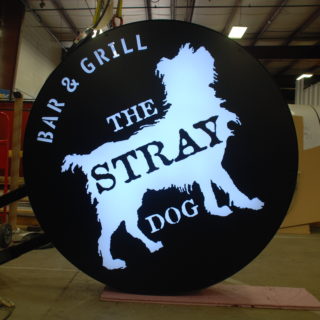Bullough’s Review on Sign Visibility
John D. Bullough recently published an informative article titled, Factors Affecting Sign Visibility, Conspicuity, and Legibility. It focuses on researched studies about different factors that affect sign visibility. Bullough breaks down sign visibility into two categories; conspicuity and legibility. His use of other research in conjunction with his own findings makes the article a scholarly and reliable source for designers, manufactures, and buyers.
Conspicuity
One of the first topics Bullough touches upon is the size of the commercial sign. Focusing specifically on conspicuity, he asserts the size of a sign should be based on the average speed a car is travelling when passing a sign. Therefore, signs on a major highway compared to signs in small towns typically can vary in size. The highway signs are much larger because of the increased speed people are travelling at compared to a small town.
Bullough claims a way to increase conspicuity is through a border. A border adds contrast to a commercial sign, which in turn makes the sign more difficult to ignore. Adding a border is a great way to make the sign stand out in any environment. The suggestion of adding a border is a reason why this article is so informative. Bullough also recognizes other attributes which add to the commercial sign’s conspicuity such as a color and letter font.

Bullough then discusses the subject of luminance and how it relates to conspicuity. While many textbooks state the importance of lighting in gaining attention, he says to keep in mind a few things. First off, it is important to make sure the lit portion of the sign provides contrast to the rest of the sign. For the sign luminance to be effective, a contrast must occur. It is also important to ensure the luminance is not too bright and could lead to distraction. Lastly, flashing lights will make the commercial sign more noticeable.
Legibility
Bullough moves on to discuss legibility by stating how much it influences the reader’s ability to process the information on the commercial sign. What he is saying is, there cannot be too much information on the sign or it will be illegible. Bullough cites prior research saying it takes about 5.5 seconds to read, understand, and respond to a sign. A sign requiring significantly more time to perform these three reactions is not very legible.
It was also found that the width of the individual characters on a sign play a large role in legibility. Bullough found one recommendation stating the stroke width should be 18% of the character height. It is important to stay close to this percentage because characters to wide or too small will decrease the legibility.
Both conspicuity and legibility determine a commercial sign’s visibility. Bullough does a great job explaining factors that increase and decrease the sign’s visibility. Careful attention to each of the conspicuity and legibility factors will lead to more successful commercial signs.
